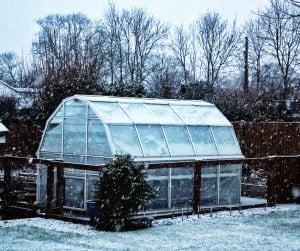
Long term greenhouse crops like peppers, chillies and aubergines, taking up to five months to mature, should be sown this month. The third week in February is ideal, mid March is fine; by the first week in April, you are pushing your luck! Water the surface of a 10cm pot of multipurpose compost with a fine rose, with tepid water and leave it to drain for at least half an hour. Sow the seeds on the surface, six to a pot; cover with a shallow layer of fine grade vermiculite. Put them in a propagator at 18-20C or on a sunny windowsill and they should germinate in three weeks. Transplant into a 9cm pot when they are large enough to handle, lifting seedlings gently by a leaf and grow on in the greenhouse at 10-15C. Make sure there is enough space between pots; pack them close together and the stems become elongated. Once the pots are well rooted plant them in their final position in a heated greenhouse in 25cm pots. If the greenhouse is unheated, sow later and don’t plant out until May.
By the end of February you should ‘Chitting’ or sprouting first or second early potatoes; allowing several shoots to develop before planting, encourages faster growth, heavier crops and is a way of beating the weather. Timing is the key – start them off about six weeks before the last frost in your area, when the soil has warmed up – there is no point in planting when the soil temperature is below 7 deg C (45 deg F), they will not grow. Put a layer of potatoes in a shallow tray or egg box with the ‘rose end’ (where most of the ‘eyes’ or dormant buds are) upwards, in a light cool frost free place at about 7 deg C (45 deg F), wait until they reach 2.5cm (1”) long and don’t break the shoots when planting. For smaller crops of large potatoes, remove all but the three most vigorous shoots; leave all of the shoots for a higher yield of smaller tubers. Have horticultural fleece or sheets of newspaper standing by in case of unexpected frosts. If you chit several different varieties over a period of time, you will be harvesting new potatoes over several months.
Snowdrops are normally planted ‘in the green’ just after flowering. However, some argue that you don’t transplant any other type of bulb when it is in leaf, so why snowdrops? It damages the roots, weakens plants and stops them from recovering after flowering. Much better to mark the clump, then lift them after they have died down, ideally in June. If you have plant snowdrops ‘in the green’, plant them as soon as possible, water well and reduce the leaf size if they show signs of stress, feeding with a dilute high potash liquid fertiliser. Bulbs planted when dormant should be plump and ready to flower the following year. If you are dividing clumps, do it when they are at their peak.
If it snows shake the snow from the branches of conifers, so the weight doesn’t make them break. Happy gardening!


